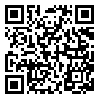Volume 8, Issue 1 (6-2021)
vacres 2021, 8(1): 36-46 |
Back to browse issues page
Department of pathobiology, Faculty of Veterinary Medicine, Lorestan University, Khorramabad, Iran
Abstract: (1597 Views)
Introduction: Many countries are presently concerned about providing a safe vaccine with minimal side-effects against COVID 19. Here, we aimed to develop a multiepitope vaccine by utilization of spike, envelope, nucleocapsid and membrane proteins of SARS-CoV-2 virus. Methods: Online servers were employed for forecasting the most robust B-cell, T-cell and IFN-γ epitopes to stimulate the immune system. Then the top selected epitopes alongside the sequence of Heparin-Binding Hemagglutinin Adhesin (HBHA) protein were applied to design a novel multiepitope vaccine, bioinformatically. The physicochemical characteristics and the protein structures of the proposed vaccine were defined using online tools. The docking process between Toll-like Receptor 4/Myeloid Differentiation Factor 2 (TLR4/MD2 receptor) and the designed recombinant structure was also investigated. Results: The designed construct had -0.210 GRAVY and 36.39 instability indices which make it theoretically stable. The designed construct was predicted to be soluble and non-allergenic. The approximate half-life of the proposed structure was computed 30 hours in mammalian reticulocytes and more than 10 hours in Escherichia coli. In its tertiary structure, 93% of the residues were in the core region and had a score of 52.73 for 3D verification and -5.55 for Z-score. Protein-protein docking of HBHA and TLR4/MD2 receptor was successful with the lowest energy of -1310.6 kcal/mol. Conclusion: The bioinformatics evaluations indicate that the designed structure is stable and immunogenic for development of a protein-based subunit vaccine against COVID-19.
Type of Study: Research |
Subject:
Vaccine development, efficacy and safety evaluation
Received: 2021/10/5
Received: 2021/10/5
| Rights and permissions | |
 |
This work is licensed under a Creative Commons Attribution-NonCommercial 4.0 International License. |




